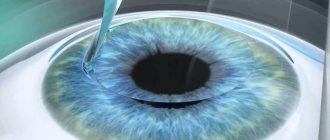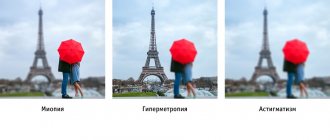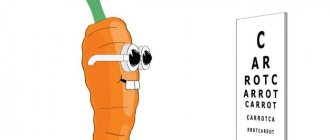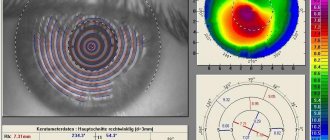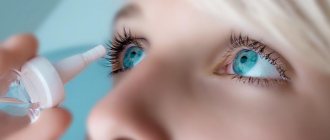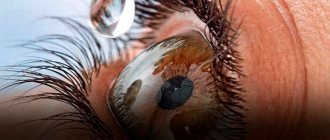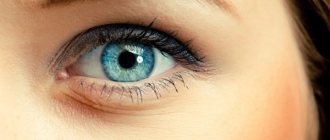Colored contact lenses began to be manufactured and used more than 30 years ago. Every year their manufacturers invent new brands and technologies to improve these products.
- without diopters - also called decorative or cosmetic, they are designed to create different images or change the usual image.
- with diopters - they can not only radically change eye color, but also correct visual impairment.
The modern market for these products allows you to visually color the iris softly and naturally (by choosing a lens shade a little brighter than your own) or try creative changes (change a dark color to bright blue or emerald). The color range of these products is very wide: from azure and violet to dark gypsy shades. Thanks to advanced technologies, changing eye color is available to people with normal vision, as well as those with vision impairments (myopia, farsightedness or astigmatism).
Lens coloring is done in various ways:
- in one or more tones;
- with the application of various textures (in the form of a star, flower petals, curls, golden embossing, etc.) or patterns on the iris area (imitation of a cat's eyes or a soccer ball).
What is it used for?
With the help of colored contact lenses you can solve a number of problems:
- Hide such a defect as an eyesore. Especially in this case, a lens that imitates a black pupil will help.
- To cope with the manifestations of diseases in which part of the iris is missing or the color of one of the sectors of the iris is changed. In this disease, a special lens with a painted iris not only “masks”, but also improves the quality of vision.
- Colored lenses are used if the eye is intolerant to ultraviolet rays. They will protect your eyes from harmful radiation better than glasses with tinted lenses.
- They are worn for amblyopia (“lazy eye”) to provide visual stimulation to the affected eye.
- Colored lenses can perform two functions at once: change eye color and correct vision.
Lens color options
Advantages and disadvantages
There are no ideal models of contact optics. This statement fully applies to tint lenses, which have both advantages and disadvantages.
Advantages:
- allow you to experiment with appearance features, achieve an interesting visual effect, and enhance the depth of the natural shade of the iris;
- do not limit freedom of movement, ideal for an active lifestyle;
- the line includes models with and without diopters, for people with normal vision;
- used to mask defects of the optic membranes for medical reasons - iris coloboma, eversion of the pigment leaf, heterochromia of the irises, cataract, etc.
Among the disadvantages of tinting optics it is worth mentioning:
- special care requirements (for reusable models);
- lower oxygen permeability;
- changes in color perception (if the lens “sits” incorrectly);
- discomfort when the pupil dilates, which may overlap with the colored area;
- there is no possibility to radically change the color of the iris (from dark to lighter).
All of these disadvantages, except the last one, can be easily eliminated with proper care of contact optics and compliance with the wearing regime. You cannot go to bed in them, ignore the replacement plan and treatment with disinfectant solutions - all this threatens ophthalmological diseases.
Types of colored lenses and their care
1. Tint . They are colored evenly, but not intensely, therefore they are intended to change the color of light eyes.
2. Colored lenses
with dense distribution of coloring pigment . They can change the color and pattern of the iris of any eye, even the darkest. Only the central zone remains uncolored, providing visual acuity; the natural color of the eyes can shine through it. 3. Crazy lenses (the term translates from English as “crazy”). Festive, disco or carnival options for changing the image instantly turn their owners into predators, vampires or sorcerers.
Colored lenses are made from the same materials as clear ones:
- made of silicone;
- from hydrogel;
- from their combination.
According to wearing time they are divided into:
- for daily colored lenses with and without diopters;
- for monthly or quarterly replacement options;
- for long-term wear lenses (for six months, a year).
The know-how of today is Korean lenses with the effect of enlarging the eyes , which is achieved by expanding the diameter of the lenses to 15 mm. (they are larger than the natural size of the iris). This type of lens has been widespread in Korea and Japan for a long time, but in Russia it is only gaining popularity.
When choosing from the variety of these products, it is important to remember that the best lenses are those that provide comfort and do not cause harm to health.
Properties
Colored contact lenses with prescriptions are made from a hydrogel base. This is a material that allows oxygen to pass through and retains liquid. Between the layers there is pigment of various shades. It is not present on the surface of the lens so that the patient does not have an allergic reaction to the chemical and pigmentation does not quickly settle.
Companies that produce colored lenses with diopters produce various models.
All of them are characterized by the following qualities:
- high throughput for oxygen, which saturates the cornea and internal tissues of the eye;
- softness, thanks to which the patient does not feel the optics in his eyes, so there is no discomfort;
- the ability to select the size of the model individually for each person, depending on the parameters of the cornea;
- free space between the center of the iris and the lens, which allows tear fluid to accumulate in this area (it additionally refracts light rays and helps moisturize the mucous membrane);
- the presence of a wide range of diopters, which are selected by the doctor individually for each patient depending on the quality of vision;
- the optical aid is applicable for myopia, farsightedness, astigmatism;
- a wide variety of colors and their shades that decorate a person’s eyes and change their image;
- in the center of the lens there is an area without pigmentation for the pupil, which is necessary for a person to view surrounding objects.
Colored prescription lenses are suitable for people who want to change their image, but at the same time correct their vision function. A person can choose. The presence of pigment in lenses does not impair the quality of vision. They also allow oxygen to pass through well and accumulate liquid.
Rules for choosing contact lenses for eyes with farsightedness
08/15/2018 Contact lenses, like glasses, are one of the main ways to correct farsightedness. Typically, lenses are chosen by those people who are uncomfortable wearing glasses due to changes in the functioning of the eye under the influence of a disease.
In addition, the lenses are much more practical and provide full visibility, unlike glasses, the visibility of which is limited by the size of the glass.
When choosing contact lenses to correct farsightedness, it is worth remembering that they must have positive optical power and help the eye “collect” a beam of rays on the retina.
Experts recommend purchasing SCLs, as they are better tolerated by the eyes, do not fall out when blinking and do not move.
When selecting both soft and hard lenses, the following are taken into account:
- Diameter
- Base curvature
- Number of diopters
- Thickness at center
- Wearing period.
Ophthalmologists select lenses individually in each case, taking into account the degree of progression of farsightedness and the presence of other diseases of the visual organ. Doctors of the medical center named after. S. Fedorov in Moscow are ready to help you choose the right lenses for farsightedness.
Farsightedness and myopia
The older a person gets, the greater the likelihood of developing farsightedness. But it also happens that a myopic eye over time begins to have difficulty seeing objects located at a short distance, and both diseases develop simultaneously.
To correct farsightedness and myopia, there are 3 types of lenses at the same time:
- Multifocal lenses. They are characterized by the presence of several zones with different optical powers (the lens looks like a target: one zone in the center is surrounded by others). When they are used, rays from objects located near and far are focused on the retina simultaneously.
- Bifocal contact lenses. They have two or three zones designed for viewing objects located at different distances. In the center of the lens there can be a zone for both near and distance. The disadvantage of this type of vision correction is that the eye does not always detect a sharp transition between zones.
- Aspheric lenses (a subtype of bifocals). The optical zones transform into one another gradually; there is no clear boundary between them, as with the previous type of lenses.
Also, patients with focusing problems can use monovision correction. Aspheric lenses are selected with a center for distance vision in one eye and a center for near vision in the other.
Astigmatism and farsightedness
For people suffering from a high degree of astigmatism and complex forms of farsightedness, multifocal lenses are unlikely to help. Such patients tolerate glasses even worse.
To avoid the unpleasant consequences of visual impairment, toric lenses are selected for astigmatism and farsightedness, which have a special shape. Their main difference from spherical lenses is the different number of diopters in the vertical and horizontal directions. Thus, one value neutralizes the manifestation of astigmatism along the desired meridian, and the second serves to restore correct focusing, impaired by farsightedness.
Night lenses
Orthokeratological (nighttime) contact lenses are widely used for myopia; they can temporarily correct the shape of the cornea and provide good vision during the day. Treatment of farsightedness with night lenses is possible, but the visual power should not be worse than +4.
In case of senile farsightedness, the use of night contact lenses is contraindicated, as it leads to progression of the disease. Night lenses deform the cornea, making it flatter.
With farsightedness, the eyeball shrinks; the use of night lenses will only intensify this process. For patients who, in addition to farsightedness, also suffer from astigmatism, orthokeratology lenses are also not recommended.
Color contact lenses
Often people want to use corrective lenses not only usefully, but also as decoration, choosing the most unexpected designs and shocking others with them.
The market offers a wide range of colored and tinted contact lenses with optical power. However, colored lenses are most often used to correct myopia.
Less commonly, suppliers sell the same lenses for farsighted people.
However, no one prescribes wearing exclusively clear lenses for farsightedness.
But any conscientious ophthalmologist will warn his patient about possible negative consequences. The pigments used in the manufacture of colored contact lenses do not allow the eye to breathe, disrupting the blood supply and functioning of the visual organs.
The influence of lenses on the development of farsightedness
Lenses do not have a direct effect on the progression of farsightedness, nor do they cure it. The main function of lenses is to reduce eye strain and stabilize the functioning of the organ of vision.
Correcting farsightedness with lenses is only a temporary aid for the patient, designed to avoid eye strain and further progression of the disease. Lenses effectively help slow down the onset of changes in the optical system of the organ, but do not prevent them completely.
However, violation of the rules for wearing contact lenses, failure to meet deadlines, and incorrect selection can cause a number of eye diseases that will join the existing farsightedness and aggravate it.
To prevent this from happening, lens selection should only be carried out by an ophthalmologist individually for each patient. Making an appointment Today: 15 registered
What it is?
The optics included in this segment have two purposes. The diopter in the lens determines the strength of its refractive power and helps to cope with refractive errors towards myopia or farsightedness. The dye of a colored lens (CL) is capable of radically changing or enhancing the natural shade of the iris, thereby performing a decorative function.
CLs with diopters can be used by patients who need vision correction, but at the same time want to slightly modify their usual image.
Several lines of corrective CLs are available to buyers:
- tint - contain a small amount of pigment, slightly modify the natural color of the iris. Suitable for patients with light eyes;
- colored - thanks to the high concentration of dye, they can radically change even the darkest color of the iris. These are even suitable for changing the color of brown eyes;
- carnival - designer models with patterns, glow and unnatural colors, used for photo shoots and themed parties. They are rarely found on the open market.
When producing CL, the manufacturer not only paints the product in a certain tone, but also works out the pattern of the iris, which gives expressiveness to the look.
Review of popular colored lenses with diopters
Colored lenses with diopters are cosmetic types that can be used to change the color of the iris. Like regular colorless ones, there are colored lenses with diopters. In addition to special aesthetics, they allow you to correct visual impairments, such as myopia or farsightedness.
There are three types: color, tint and carnival. Only tinted and colored ones have optical power; carnival ones are not used for vision correction.
Colored ones have a more saturated color due to a two- or three-layer structure of pigment application. They can completely or partially overlap the original iris pattern, making some suitable for changing dark brown eyes to any other color you like.
Tints are usually intended for light color types. They add shine to the look and highlight the natural beauty of the native pigment.
Colored ones have a wide range of colors, making it possible to create a memorable individual style that you have long dreamed of.
Colored lenses with diopters are somewhat different from colorless corrective lenses:
- They are usually thicker than clear correction ones. If you are a beginner and want to try something new in your appearance, it is better to start with tint. This will make it easier to understand whether you are comfortable wearing a thicker composition in the future;
- Some have a rich structure of applied pigment, which slightly blocks the viewing angle at the time of day when the pupil is dilated.
Popular, best colored lenses with diopters in our online store:
- Marquise
Marquise is a European brand that has been producing premium quality soft hydrogel lenses for over 10 years.
Main advantages:
- Thanks to the modern production method, they are used for 14 hours a day without causing discomfort, do not dry out the cornea and provide a moisture content of 52% for up to one year;
- Uniform pigmentation allows you to achieve the most natural coloring of the iris. The line also includes lenses with a black border on the outer edge to give a “doll-like” look.
Examples of European Marquise suitable for light color types:
- Light gray crystal;
- Gray-green sky gray;
- Royal blue;
- Gray with light gray rim;
- Gray-blue dolls essvase blue.
Examples of European Marquise lenses suitable for brown tones:
- Green white green;
- Honey with elegance brown rim;
- Gray-blue essvase blue.
- Rainbow
Premium quality lenses made in Turkey, manufactured using Italian technology. They appeared on the Russian market relatively recently, but have already proven themselves to be excellent.
Main advantages:
- Made from polymacon polymer, which is resistant to protein deposits;
- High oxygen permeability coefficient - 32.5, moisture content up to 40%. Due to this, the product can be worn for up to 12 months without unnecessary discomfort;
- UV protection from sunlight;
- Both tinted and colored ones are presented, capable of radically changing the original color.
The following models are suitable for light ones:
- Light blue baby blue;
- Green blondy. Not darkened, they go well with bright makeup and emphasize natural beauty;
- Emerald verde. Bright and rich. Suitable for a bright look at photo shoots, or will highlight your image at various events.
Ideal for brown ones:
- Honey tint amber will give a nutty-honey color that will emphasize the tenderness of natural beauty;
- Light gray ice can cover even a jet-black iris. Due to the absence of a dark rim, they look natural and are amazing for everyday wear.
- Adore
Italian-made lenses with a black rim are designed to highlight the natural color of the eyes. Made, like the Turkish rainbow, from polymacon polymer. Moisture content up to 52%, service life up to three months. They do not require additional care until the end of wear.
Suitable for both light and brown:
- Aqua (gray-blue) can also be suitable for covering the native dark brown color;
- Blue - gorgeous cornflower blue with a black rim;
- Green - amazing emerald. Creates a unique hazel tint on brown eyes.
In our online store you will find and select for yourself soft, durable, best colored lenses with diopters from various proven foreign brands that have proven themselves in the Russian market.
Tips for choosing lenses
Regardless of whether you buy lenses with diopters, or want to purchase regular cosmetic models, you need to select them only with a doctor. There are several reasons for this:
- The physician must determine whether you have any contraindications to such optics, for example, allergic reactions.
- In case of deviations in visual acuity, only a doctor will be able to select adequate models with diopters.
- The ophthalmologist will also help you select samples based on pupil diameter and corneal radius of curvature.
In addition, only a specialist can help you learn how to put on and remove such lenses if you have never done this yourself before.
Colored lenses for blue eyes
Are colored lenses harmful to the eyes?
There is an opinion that the dye has a negative effect on the mucous membrane of the eyes. But modern painting technologies use very high-quality and environmentally friendly materials or safe methods of applying paint to the inner surface of lenses.
In some cases, a narrowing of the visual field or poor correction may be observed; this happens when the lenses are incorrectly selected (incorrect radius of curvature or diopters).
Infection of the eye mucosa is caused by irregular lens care and neglect of personal hygiene measures.
What you need to know about such lenses
Tinted lenses provide the opportunity to make small changes to your appearance. But it is worth noting that such lenses are more suitable for people with light eyes, since they cannot completely change the color, but can make the eyes more expressive and deep.
Tinted colored lenses can be used both to give a slight cosmetic effect (zero correction lenses) and to correct visual acuity. For people with good vision, tint lenses with zero correction are suitable, which will only change the natural shade of the eyes. But lenses with diopters will not only change color, but will also correct vision.
Read what diopter contact lenses are used for here.
Acuvue Colors
These lenses are completely safe for the eyes. The layer on which the paint is applied does not contact the surface of the cornea. Some tint lenses have a contour that fades smoothly from the tinted area to the clear area. This allows you to visually make your eyes larger, and everything looks very natural.
Cases when tinted lenses are used for medical purposes:
- For iris disorders;
- For opacities of the cornea;
- For eye diseases that require protection from sunlight;
- When training an eye that has a pathology.
Multi-Curve
Wearing Features
CLs for vision correction are produced in accordance with several wearing modes - from one day to six months.
More details about the rules of use are specified in the product instructions. It needs to be studied first. But owners of this kind of product must take into account that all color models are thicker than conventional soft optics. This means that the eyeball experiences a lack of oxygen during use of the product, which can lead to tissue hypoxia.
All pigmented lenses must be removed at night, and models such as carnival ones cannot be worn for more than 4-5 hours at a time.
Corrective and colored lens on one eye
It is allowed to wear 2 contact vision correction devices at once. This need often arises for CL users with myopia and hypermetropia.
Soft lenses made of thin hydrogel can be placed one on top of the other. Such an adventure will not work out of thick and hard material. The obstacle is the large thickness. The lenses won't stay on. When putting on 2 products at the same time on one eye, complications may develop.
The outer shell of the organs of vision does not have vessels to receive oxygen through them. When using 2-3 or more CLs at once, the cornea does not receive enough of it, or it is completely blocked.
This leads to hypoxia. The cornea is literally suffocated under a thick layer of artificial material. This threatens the growth of blood vessels into the outer shell of the eyeball and the development of cataracts.
Using 2 types of lenses damages the surface of the eye. Which ends with various kinds of infectious pathologies, inflammation, which causes loss of visual perception.
Use in daily life
Using such tools is simple and they are no different from standard ones. They are usually worn during the day, especially if they are cosmetic products. In the dark, due to the dilation of the pupil, a sensation of “veil” arises from the overlap of pigment in the visual area.
How to use the solution
After wearing, the lenses are placed in a solution. This applies to those models that are designed for multi-day use. When they are removed, they are placed in a container with disinfectant liquid. You can choose any:
- Biotrue;
- ProActive;
- Opti-Free;
- Silver;
- UnicaSensitive;
- Maxima;
- HighFresh.
It is worth carefully reviewing the instructions, because certain types of products are used only for severe contamination once a week. It is better to use multifunctional compounds.
How to wear
How to use for the first time:
- To wash hands.
- Place the lens on the tip of your index finger.
- Look up, pulling the lower eyelid down and the upper eyelid up.
- Carefully place the lens on the lower part of the eyeball.
- Look down, then close your eyes for a couple of seconds.
- Blink your eyes a few times.
How much to wear
The manufacturer himself specifies the time frame – 4-12 hours. Ophthalmologists point out that the products have lower oxygen permeability, like conventional options, and therefore continuous operation is no more than 6 hours.
Popular manufacturers
New series of tint models appear on the modern optics market almost every day. But 4 brands that have gained authority remain in demand.
Acuvue. Two-week tint lenses available in the Acuvue 2 Colors Enhancers line. The manufacturer offers three color solutions - turquoise, blue and green. The material used for production is very soft and flexible etafilikon A with hypoallergenic properties.
The models are suitable for blue eyes, gray eyes, as well as for patients who cannot tolerate silicone hydrogel. Etafilikon lenses are equipped with an ultraviolet filter and consist of 58% water. Due to low oxygen permeability (33%) Acuvue 2 Colors Enhancers can be worn for no longer than 8 hours per day. The approximate price is 1600 rubles for a pack of 6 pieces.
Infinity. Tinted contact lenses “Infinity” are made using double-sided Lath Cut technology. This ensures increased optical accuracy of the product and stability of parameters. The lenses fit perfectly on the cornea, do not slip and do not interfere with the natural circulation of tears.
The thickness of the lens in the center is 0.06 mm, the product is even thinner at the edges, which guarantees increased comfort of use. The correction means can be selected individually according to the radius of curvature and optical power. Available shades are sea, blue and green. Price – 550 rubles per bottle with 1 lens.
Ultra flex. The OL Ultra flex Tint series from CooperVision with an even and thin coloring of the inner layer. The replacement mode, depending on the characteristics of the model, ranges from 3 to 6 months with a mandatory night break in wearing.
The manufacturer has taken care of comfortable use of the optics - the thickness of the product with a very thin edge profile is only 0.04 mm. The oxygen permeability indicator is 23.5 dk/t, and the moisture content is 38%. The special non-ionic material FDA I makes the OL resistant to protein deposits and dehydration. The estimated cost of one Ultraflex lens is 850 rubles.
Fresh look. Tinted optics for a month with daytime wear. Guarantees wide viewing angles and excellent peripheral vision even in poor lighting conditions.
Available shades:
- Sea Green - green;
- Caribbean Aqua – turquoise;
- Pacific Blue - blue.
What type of vision can you wear contact lenses for?
Most ophthalmologists say that you can wear lenses for any vision parameters. Since these optical products can correct both minor and serious visual deviations. Or simply be an accessory to change your look (this applies to colored lenses). Since they are available even with zero diopters, they can be worn regularly by people with perfect vision.
First of all, medical indications for the use of lenses will be high degrees of refractive error (myopia or farsightedness) and astigmatism. Especially if the patient has different optical power readings for each eye. Such a patient will not be able to correct visual acuity with the help of glasses. Among other things, wearing lenses provides a wider view and does not hinder movement during active activities.
Today, manufacturers produce contact vision correction products with various diopter values. Experts recommend starting to wear lenses even with a slight refractive error, for example, from -0.75 to -2. This will increase visual acuity, and in the future the person may not need correction, because it will probably become 100 percent.
As for products with high optical power ratings, this is the best alternative to glasses for the correction of visual pathologies. Firstly, lenses do not change the scale of objects located both at close and long distances, but transmit the image in real size. Secondly, with very poor vision, eye lenses do not distort the user’s appearance (they do not make the eyes smaller or larger), as happens when using high-diopter glasses.
If you decide to buy lenses, you must undergo a comprehensive eye examination. The doctor will select the optimal optical products for you that you can wear without fear for your eye health. In the future, you can choose the type of lenses based on your own lifestyle and needs. For example, you can wear colored lenses if the user has a desire to become brighter or radically change their appearance. The main thing is to follow the rules for caring for them in order to avoid infection and other complications. Since protein deposits and other contaminants may accumulate on the surface of products.
The online store for contact vision correction will help you find any lenses and related products that meet your needs. The site presents only high-quality products at affordable prices. You can order a product at any time, just place it in your cart, fill out an application and lenses that you will be happy to wear will give you excellent vision and unsurpassed comfort. Descriptions of each product and reviews are on its page.
Tips for caring for lenses
In terms of care, colored lenses are practically no different from their regular untinted counterparts. To ensure that you never have any difficulties working with them, it is enough to follow these recommendations:
- Always handle lenses only with clean hands and sterile instruments. It is recommended to wash the optics itself both after removal and immediately before putting it on. Otherwise, your risk of getting a mucous infection when installing a lens will be quite high.
- Store products in special containers and only in fresh solution. Use materials recommended by the manufacturer to clean them.
- Always follow the manufacturer's instructions for inserting the lens.
- Check the integrity of the samples before putting them on. Make sure your lens is free of tears, stains and other defects. Otherwise it shouldn't be used.
- Strictly follow the recommendations for wearing such products. So, if the manufacturer has instructed you to throw away the lens 24 hours after unpacking, you should not put it on again the next day. Similar rules apply to products that are intended to be worn for a month or more.
- Never use lenses if your eyes are watery, inflamed, or have other symptoms of fatigue or illness. The same applies to common ailments, including colds and flu.
- Do not give lenses to another person, even if it is your relative. Such actions can lead to infection with various infectious or fungal diseases.
It is enough to do this once every six months. This will help you promptly adjust the type of optics if your visual acuity changes, as well as select new high-quality products for yourself as soon as they go on sale.
Selection of contact lenses for myopia
Contact lenses are available in two main versions: soft and hard. However, rigid lenses are rarely used - only in some clinically difficult situations. Soft contact lenses are much more well-known, common and comfortable.
Based on the material from which they are made, lenses are also divided into two types:
- silicone hydrogel lenses;
- hydrogel lenses.
Lenses can be recommended, calculated and prescribed exclusively by an ophthalmologist - after a thorough diagnosis of the entire visual system. This is due to the fact that a number of important optical characteristics cannot be selected “at random”, without preliminary special studies of the functional state and structure of the eyes. When selecting contact lenses, the following properties are also taken into account:
- Material. Silicone hydrogel lenses are considered safer and biocompatible. According to patient reviews, they are more comfortable to use.
- Radius of curvature (BC, BCR). This indicator must correspond to the shape of the cornea - it is purely individual. If the curvature is chosen incorrectly, wearing lenses can be uncomfortable or even harmful.
- Lens diameter (D, OAD). The diameter is also individual and depends on the size of the eyeball.
- Optical power. This is the main indicator that provides vision correction for myopia (measured in diopters with a minus sign).
- Cylinder axes. This indicator, measured in degrees, is of key importance for astigmatism.
- The thickness of the lens is measured at its center point.
- Wearing mode. Lenses from different manufacturers have different properties, so the recommended wearing mode is always indicated in the attached instructions. Any lenses must be removed for a certain period of time. This gives your eyes a rest while the lenses themselves are treated with a special solution. In daytime mode, the lenses are removed at night and placed in a special container. Extended mode - lenses are not removed for a week. Flexible mode - it is allowed to wear lenses for 1-2 days between breaks in wearing. Finally, continuous mode allows you to keep your lenses on for a month.
- Replacement frequency. This indicator, depending on the manufacturer and type of lenses, can vary greatly - from disposable to requiring replacement every two years.
- Shape and structure - first of all, lenses must correct existing deviations. Spherical lenses are prescribed for myopia and farsightedness; toric correct astigmatic vision.
When choosing hydrogel lenses for more comfortable wearing, it is recommended to choose models with maximum moisture content, as they provide the best access of oxygen to the cornea of the eye. Silicone hydrogel lenses are more versatile in this sense, since the movement of oxygen in them is not related to the water content.
Specifics of wearing mode
The mode of wearing colored lenses in the vast majority of cases completely depends on what type they are. Possible variations are:
- Up to 3-4 hours: this mode is typical for carnival lenses. They have a denser structure, therefore, when worn for a longer period of time, they lead to eye fatigue and can cause inflammatory processes.
- Up to 6 hours – regular colored lenses.
- Up to 8 hours - tinted lenses for daytime wear.
Varieties of colored lenses that imitate the natural appearance of the pupil.
It is extremely rare among this type to find examples of prolonged wear.
In addition to this classification, lenses can also be divided into samples for daily replacement, monthly, quarterly, and also annual lenses. All of them are comfortable to wear in their own way. The patient only needs to choose the optimal mode of use for himself.
Adria Color 3 Tone colored contact lenses
Tips for caring for lenses
There are a number of fairly simple rules that will protect your eyes from troubles:
- You need to put on lenses before applying cosmetics to your eyes, and remove them after the cosmetics have been washed off.
- Before putting on and removing lenses, wash your hands thoroughly. This will protect your eyes from the possibility of bacterial infection.
- Tinted lenses can be damaged by dust and smoke. Therefore, you should avoid prolonged exposure to smoky and dusty conditions.
- Lenses intended for long-term wear should be stored in a container with a solution for cleaning and disinfection.
- To clean lenses from accumulated plaque that cannot be removed with a regular solution, it is recommended to clean them once every ten days using special tablets or solutions.
- Under no circumstances should you wear tint lenses for longer than stated.
- You should not sleep in lenses; it is not recommended to wear them for more than eight hours a day.
- You need to take a responsible approach to choosing a solution for storing and disinfecting lenses. If it is chosen incorrectly, increased eye sensitivity may occur and the risk of allergic reactions increases.
- For particularly sensitive eyes, you should choose special solutions.
You will learn how to choose the right solution for storing lenses from this material.
Main manufacturers and prices
4 brands deserve special attention - their labels are in steady demand and receive good reviews from users.
Acuvue
Beauty models are produced using the “beauty plus comfort” technology. They contain a special component that ensures optimal hydration of the mucous membrane and pleasant use throughout the day. The line includes two types of CLs:
- Natural Sparkle - makes eyes bright and shiny;
- Natural Shimmer - gives the look expressiveness and unique depth.
The palette includes dark and light shades, the optical power is selected individually - from minus 0.5 to minus 0.9. Painted optics from Acuvue are equipped with an ultraviolet filter and are designed for daily wear. The package includes 30 lenses, their estimated price is 1,200 rubles.
Adria
The Korean manufacturer Adria offers the largest range of CLs with diopters:
- with the effect of big eyes;
- with an intricate pattern for a deep look;
- tinted with a radiance effect;
- a range of natural shades for light eyes;
- rich colors for dark-eyed clients;
- carnival models;
- neon models glowing in ultraviolet.
All lines include models for normal vision and for refractive error correction from -0.5 to -9.0 diopters. Each package contains a blister with two products, the price per package is approximately 1100 rubles.
Ophthalmix Colors
These CLs feature an advanced design that makes wearing even more comfortable. Thanks to the optimal level of moisture content (42%), the optics help you feel comfortable even in rooms with very dry air. Decorative lenses will help correct vision in the range of minus 0.5–8.5 diopters and give the iris a rich color:
- cornflower;
- green;
- pearl gray;
- violet;
- sky blue;
- brown;
- black night;
- nutmeg.
Products from Ophthalmix are quarterly replacement models. For a package of two products, sellers ask from 890 rubles.
Ultra Flex
American hydrogel lenses for light eyes. The Ultraflex company offers three shades of optics - aqua, blue and green. CLs are designed to correct small refractive errors - no more than minus 1.0 diopters. Thanks to its biconvex structure, the product retains its shape and improves the supply of oxygen to the tissues of the eyeball.
It has a long wearing period - up to 9 months, subject to the morning/evening regimen and proper care. You can buy the product for 1000 rubles - that’s what one lens costs, placed in a special bottle.


